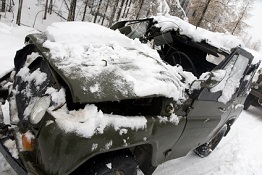 Another week of winter and yet another winter storm. Whether it was called Nemo or Q (as the latest system has been dubbed) the entire U.S. has seen some kind of inclement weather during this harsh season.
Another week of winter and yet another winter storm. Whether it was called Nemo or Q (as the latest system has been dubbed) the entire U.S. has seen some kind of inclement weather during this harsh season.
It’s even stopped the pros today at the links—in Arizona.
Such widespread wintertime weather means no driver in any state is safe (forecasts predict snow to also be dumped on Northeastern states this weekend), so it’s probably a good time to brush up on your insurance and car needs.
What Does My Policy Need?
If you want to get insurance coverage that deals specifically with the damaging accidents that Old Man Winter brings, your basic liability policy won’t cut it.
But these parts of your policy can:
–Collision: Car damage can be caused easily when weather gets wet and/or wild. Collision covers damage whenever your vehicle strikes or impacts an object, so think about all of the situations that icy roads can create. With just one slide or skid, control of your car can slip away and send you right into an object that breaks an axle, twists your bumper, or worse.
–Comprehensive: If car damage can be linked to situations that are “other-than-collision,” a policy with comprehensive coverage will come in handy. And there are plenty of those situations when it comes to weather: flying balls of hail cracking your window; an icy tree branch falling in your windshield; that deer migrating from the snowed-out mountaintop you couldn’t dodge in time. Given the wide range of hazards that the road brings, 3 out of 4 policyholders decide on this coverage, according to the Insurance Information Institute, which holds comprehensive as a valuable buy for motorists.
Remember that collision and comprehensive are additional purchases, so consider your car, it’s value, and the cost of the deductible to see if it’d be worth it to protect your vehicle against situations beyond your liability coverage.
What Does My Car Need?
Insurance will cover you after a situation, but what if you’re right in the middle of it?
Being stuck in a snowed-in car (or in a car on snowed-in roads) can be dangerous for the unprepared. The National Highway Traffic Safety Administration offers these tips so you’re not caught unaware (follow this link for entire list of tips):
–Visit the mechanic for a checkup. Think of those fluid topoffs and part tuneups as the flu-shot equivalent during winter
–To deal with weather so you don’t get stuck, stock your trunk with: a snow shovel, broom, ice scraper, jumper cables, and flashlight
–In the case you are stuck/stranded, you’ll want to have: blankets, a cell phone, water, and food
–And in the case you are stuck for a long time, don’t run your car to keep warm for extended periods of time. With the window up and your exhaust stuffed with snow, you could fall victim to carbon monoxide poisoning.
The AAA Foundation for Traffic Safety offers these following videos for driving tips to keep you cool during those dangerous situations that icy roads often create. And don’t mind the ’80s-era station wagons, these tips apply to all vehicles:
–How to recover from a skid
–How to brake properly
–How to drive safely in general during winter (a good 12-minute overview)
Snow Doesn’t Stop Thieves
It might be a snowday for students, but the some out other are never out of session.
Wintertime’s harsh conditions help car thieves thrive on so-called “puffer thefts,” called as such because of the exhaust puffs that make those vehicles an easy target.
Unsuspecting drivers often leave their cars on and outside in the winter cold, maybe to warm up the heater or simply because they forgot their hot cocoa inside. Those drivers could only spend a few minutes away from their car, but car thieves who have scoped out their puffer are waiting to scoop it up for an easy steal.
Ohio and Colorado officials offer these tips and advisories to drivers who want to protect themselves against puffer thefts.